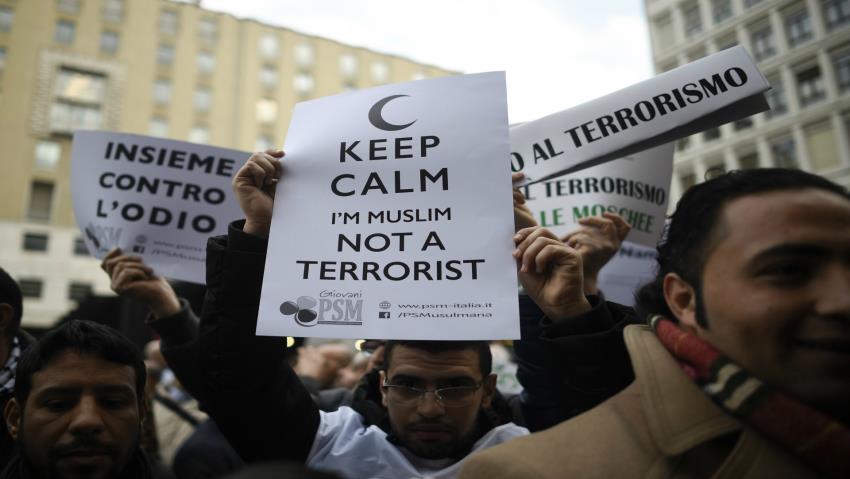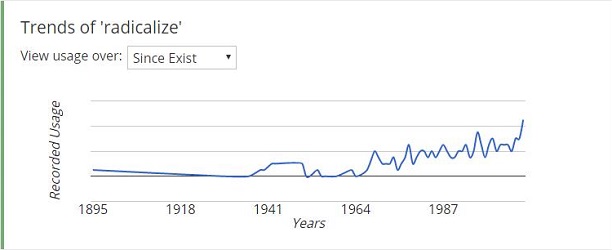
Is academic discussion about radicalisation a part of the problem?
by Lucy Hodgkin
The term ‘radicalisation’ is defined as “the process by which a person comes to support terrorism and forms of extremism leading to terrorism” (The House of Commons: Home Affairs Committee, 2012). The interest and use of the word ‘radicalisation’ is now at an all-time high, with a peak in its use around the Second World War and a constant rise from the 1960’s onwards. This is shown below in Figure 1 (Harper Collins, no date).

Figure 1: Use of the term ‘radicalisation’ (Source: Harper Collins, no date)
Of course, the topic of radicalisation is a controversial one, with personal and moral views being voiced from all sides of the relevant arguments. Because of the topic being incredibly ‘hot’ in the media and academic sectors, there are many formal academic writings about radicalisation – defining it, arguing with what it means and breaking it down. There are, however questions to address about these academic writings, which are regarded as highly respected works. Is academic writing changing the way we think about radicalisation? Is our image of a radical changing due to the publicised academic writings? More importantly, there are also questions to ask about whether these things are increasing the radicalisation of individuals indirectly.
There are many arguments to suggest that yes, academic writings are actually making the problem of radicalisation worse, in all aspects. These are arguments I would be more inclined to side with. Firstly, the very blurred definition of radicalisation in different contexts can lead to confusion. There are many contexts in which radicalisation may be referenced, but the three predominant contexts are the security context, the integration context and the foreign policy context (Sedgwick, 2010). Security focuses on radicalisation as a direct threat to the state, integration focuses on the neo-nationalism sub-category of radicalisation, and foreign policy focuses on the agendas of governments and bodies of authority. Therefore, when writing academically, these differences (if not highlighted, which is not a common occurrence) can cause mislabelling, contradictions, incorrectness or even offense. These confusions can arise in the form of racial and religious profiling. An example of this would be the NYPD’s ‘4 Stages of Radicalisation’ (Kundnani, 2012):
- Pre-radicalisation
- Self-identification
- Indoctrination
- Jihadisation
The problem with this system is that it assumes the religion, and therefore creates an appearance stereotype, of the radical individual. When these ideas are published in formal writings from trusted social institutions, the ideas trickle down into online and real life forums, where ideas are debated and spread. Therefore, this example of profiling, alongside many others is actually creating a public image of what a radical looks like as these ideas travel through to the public through mediums like social media.
This is a severe problem, as academic discussion is moving away from ‘old terrorism’ to ‘new terrorism’. The concept ‘old terrorism’ has been nearly abolished due the introduction of the idea of ‘new terrorism’. ‘New terrorism’ is the Islamic terrorism behind 7/7 and 9/11, as opposed to ‘old terrorism’ which is the type of terrorism that occurs in nationalist and leftist violence (Kundnani, 2012). The academic writings since 2005 have therefore been focused on ‘new terrorism’ and are pushing the stereotype of terrorism and radicalisation towards the East. For example, think tanks, anti-terrorism academics are now focusing on stereotyping the type of radicals we should be combating. This is rejecting the idea that ‘home-grown’ terrorism still exists and therefore reinforces white privilege and a lack of integration.
This in turn brings out resentment and hostility towards Western European countries. Europe is therefore becoming one of the “main terrorist support groups”, as Arul Kundnani highlights in his paper Radicalisation: the journey of a concept. The main ideas presented are about the radicalisation of second generation immigrants as a process that occurs when Muslims move to the EU and fail to integrate into society due to the influence that stereotyping and racial profiling has had on the perception of these people. This failure to integrate leads to resentment and hostility against Europeans and therefore may increase the development of Islamic terrorism in Western Europe. Terrorism is simply entrenched in a wider problem of youth aggression and anger against the system in which they were raised.
It is clear that academic writings are indirectly impacting the way we all view radicalisation, and therefore part of the problem; however, there is a complex point to raise in terms of how academic consultancy about radicalisation impacts us, too. Academics who specialise in radicalisation are often called on for their consultation skills. Governments tend to hire academic consultants on niche topics in order to gain advice about policy making. For example, Dr Sara Silvestri, a senior lecturer in International Politics who does research into Islam and the Middle East at City University of London has done some policy work with the British Council. (City, University of London, no date). She has also published a chapter on Misperceptions of the ‘Muslim Diaspora’ (Silvestri, 2016). The thing to realise about this is that the advice academics give will be relevant to the nation’s views they are writing from the perspective of. This can lead to confusions about the definition of radicalisation and certain uncertainties about who is considered a radical, and what to do about them. This is, however, very admirable work and should not be overlooked.
To come to a conclusion about this problem is difficult considering all impacts of academic writing on radicalisation are indirect, so it is difficult to say how much of the problems mentioned are actually caused by academic articles, reports, journals or chapters. That being said, there is definitely a problem with how highly acclaimed these papers are due to their possible lack of accuracy or specification. As academic “knowledge” trickles down into common knowledge, there is a danger of it being skewed or misunderstood – or worse, taken as fact. This is especially a problem when the academic knowledge isn’t obviously grounded in a particular discourse. This is why the academic “knowledge” is such a part of the problem, because it reinforces opinion and personal values as fact – which is why many people in society think terrorism and radicalisation is exclusive to Islam.
References
- Harper Collins: English Dictionary (no date). Trends of ‘radicalize (Accessed: 26 April 2017)
- The House of Commons: Home Affairs Committee (2012). Roots of violent radicalisation Volume 1. (Accessed: 26 April 2017)
- Arun Kundnani (2012). ‘Radicalisation: the journey of a concept’. Race and Class. SAGE London [Online]. Available at: ‘Radicalisation: the journey of a concept’. Race and Class (Accessed: 26 April 2017)
- Mark Sedgwick (2010). ‘The concept of radicalization as a source of confusion’. Volume 22. pp. 479-494 (Accessed: 26 April 2017)
- Sara Silvestri (2016). ‘Misperceptions of the ‘Muslim Diaspora’’. Current History, Volume 115. pp. 319–321 (Accessed: 26 April 2017)
- City, University of London (no date). ‘Dr. Sara Silvestri’ (Accessed: 26 April 2017)

0 Comments